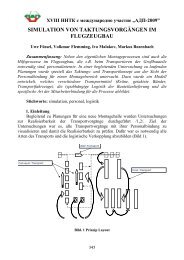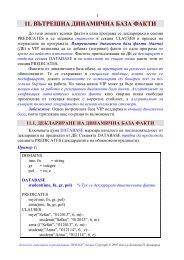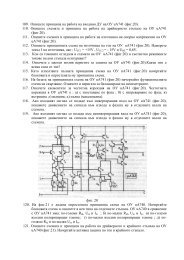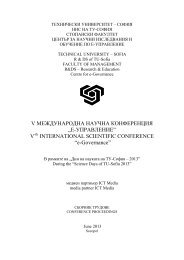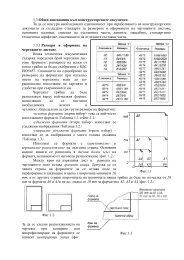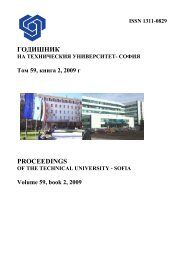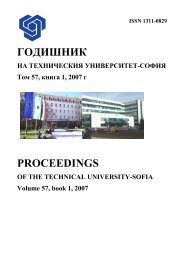All the elements of the semiring ID(E(L)) are both additively neutral andmultiplicatively neutral.It follows that it is the Viterbi semiring (see [6] for moredetails about the Viterbi semirings).5. TOWARDS A CONCRETE CRYPTOSYSTEMThe following lemma is a straightforwardLemma 5.1 Let M and N be n × n symmetric matrices with entries in thesemiring R. If R is a commutative semiring, then MN = NM.If R be a commutative semiring and SMat n R be the semiring of symmetricmatrices with entries in R. Then from Lemma 5.1 immediately followsProposition 5.2 SMat n R is a commutative semiring.Extended Die-Hellman protocol is the following procedure:1. Alice and Bob agree on a nite commutative semiring R. They choose apositive integer n and a matrix X ∈ Mat n (R).2. Alice chooses matrices A 1 , A 2 ∈ SMat n R and computes a matrix A =A 1 X A 2 . She sends A to Bob.3. Bob chooses matrices B 1 , B 2 ∈ SMat n R and computes a matrix B =B 1 X B 2 . He sends B to Alice.4. Their common secret key is thenk = k a = A 1 B A 2 = A 1 B 1 X B 2 A 2 = B 1 A 1 X A 2 B 2 = B 1 A B 2 = k b .The corresponding BSAP that should be hard is : given matrix X of a commutativesemiring SMat n R and matrix Y = A 1 B 1 X B 2 A 2 , nd four matricesA ′ 1, B 1, ′ A ′ 2, B 2 ′ such that Y = A ′ 1 B 1 ′ X B 2 ′ A ′ 2. We do not know if it is necessary foran attacker to solve this problem,but it is sucient.Consider the semiring R = ID(E(L)) as dened above.Let SMat n R be thecommutative semiring of symetric matrices with entries in R.Alice chooses matricesA 1 , A 2 ∈ R and computes A = A 1 X A 2 . Matrices A 1 , A 2 are chosen as private keysby Alice in Extended Die-Hellman protocol 5.3.If we consider matrix semiring SMat n R with n = 2 then Alice has 16 3 choicesto choose a matrix A 1 and the same choices for matrix A 2 .Assume Alice has chosen the matrices A 1 and A 2 in the following particularwayA 1 =( a bb c), A 2 =( d ee f), where a, b, c, d, e, f ∈ R.36
The only way we know for an attacker to break this system would be to ndmatrices A ′ 1 and A ′ 2 such that A ′ 1 X A ′ 2 = A ( or,to solve similar problem in termsof the matrix B Bob computes).A brute force search will depend on the size of the set M = {A 1 X A 2 }. If thesize of the matrices A 1 , A 2 is n = 2, an immediate upper bound for the size of thisset is 16 3 .16 3 = 2 18 . It will requires further research to estimate better the size ofM and to understand how the sizes grow as we increase both the matrices involvedand the commutative semirings.In order to describe the eciency of the system we have to say that if Alice andBob agree on a matrices of size n and a commutative semiring R with cardinality|R| = θ ,then the public key and the data to be transmited has O(n 2 lg θ) bits .6. CONCLUSIONIn this paper we study how the generalization of the discrete logarithm problemresults in the semigroup action problem. When the semigroup is abelian, arises anatural Die-Hellman key exchange and a sucient condition to break the keyexchange system is to solve semigroup (bi-semigroup) action problem. In section4 we consider a special semilattice L and its endomorphism semiring E(L). Theaddition and multiplication tables of the subsemiring ID(E(L)) coincide. In thelast part of the paper we concentrate on a particular bi-semiring action.Usinga commutative subsemiring of endomorphism semiring of a nite semilatice of aspecial type we propose a concrete cryptosystem. It will require further researchto assess the security of such cryptostem.References[1] I. Anshel, M. Anshel and D. Goldfeld (1999), An algebraic method forpublic-key cryptography, Math. Res. Lett., 6 (1999), 287 - 291.[2] S.Blackburn, C. Cid, C. Mullan (2010), Group theory in cryptography,arXiv: 0906.5545v2 [math] (25 Jan 2010).[3] W. Die, M. E. Hellman (1976), New directions in cryptography. IEEETrans. Information Theory, IT-22(6) (1976) , 644 - 654.[4] T. ElGamal (1985), A public key cryptosystem and a signature schemebased on discrete logarithms, IEEE Trans. Inform. Theory 31 (1985) , 469 - 472.[5] S.Galbraith, A.Menezes (2005), Algebraic curves and cryptography,Finiteelds and applications, 11 (2005), 544 - 577.[6] J.S.Golan (1999), Semirings and their application, Kluwer Acad.Publ.,Dodrecht (1999).37
- Page 1 and 2: ISSN 1311-0829ГОДИШНИК НА
- Page 3 and 4: Годишник на Технич
- Page 5 and 6: Годишник на Технич
- Page 7: Годишник на Технич
- Page 10 and 11: • If a neutral element 1 of the s
- Page 12 and 13: Proof. (i) Since for arbitrary ≀
- Page 14 and 15: )is the endomorphism ≀ 0, . . . ,
- Page 16 and 17: ∣∣E (k)C n∣ ∣∣ =Propositi
- Page 18 and 19: For k = 0 and s = 1 from the last p
- Page 20 and 21: Facts concerning semilattices can b
- Page 22 and 23: described by the following join-tab
- Page 24 and 25: Finally we observe{aj , if i = k(f
- Page 26 and 27: Let us consider the endomorphisms f
- Page 28 and 29: Proposition 3.8 For any n ≥ 2 in
- Page 30 and 31: Cryptographic protocols based on DL
- Page 32 and 33: 2.5 Bi-Semigroup Action Problem (BS
- Page 35: Theorem 4.5 [14]. In the center of
- Page 39 and 40: Годишник на Технич
- Page 41 and 42: The exact definitions of points and
- Page 43 and 44: FirstIterationSecondIterationx 0 0
- Page 45 and 46: * x4. Order of approximationBecause
- Page 47 and 48: Годишник на Технич
- Page 49 and 50: генератори, присъе
- Page 55 and 56: № РежимТабл.4.1 Бала
- Page 57 and 58: Годишник на Технич
- Page 59 and 60: Табл.11 2 3 4 5 6 7Загуби
- Page 61 and 62: оцени разхода на ак
- Page 63 and 64: сформатора се нала
- Page 65 and 66: -да допуска претова
- Page 67 and 68: Годишник на Технич
- Page 69 and 70: -големи трудности п
- Page 71 and 72: трансформаторът се
- Page 73 and 74: При известно фазов
- Page 75 and 76: KU BHOCHR (12)w w wЗа да се
- Page 77 and 78: Годишник на Технич
- Page 79 and 80: aided impregnation of wood and wood
- Page 81 and 82: different as a result of the differ
- Page 83 and 84: Table 2. Carbon peak C s1 component
- Page 85 and 86: Годишник на Технич
- Page 87 and 88:
esults indicating that the reductio
- Page 89 and 90:
Change of Mass M, %100-10-20-30-40
- Page 91 and 92:
However, the correlation between re
- Page 93 and 94:
Electrical Apparatus and Technologi
- Page 95 and 96:
Годишник на Технич
- Page 97 and 98:
- преходът към стри
- Page 99 and 100:
или магнитно изоли
- Page 101 and 102:
от лист електротех
- Page 103 and 104:
Фиг. 6. Изменение на
- Page 105 and 106:
Годишник на Технич
- Page 107 and 108:
Fig.1 Block structure of proposed o
- Page 109 and 110:
Fig.4. Initial and best shape of po
- Page 111 and 112:
Fig.8 Calculated initial cogging to
- Page 113 and 114:
Годишник на Технич
- Page 115 and 116:
Octave/Lua interface is a Matlab to
- Page 117 and 118:
pends on the results of the thermal
- Page 119 and 120:
4. ResultsAs it has been mentioned
- Page 121 and 122:
A DC electromagnetic actuators with
- Page 123 and 124:
Годишник на Технич
- Page 125 and 126:
ращ се наблизо пров
- Page 127 and 128:
Фиг. 4. Зависимост н
- Page 129 and 130:
че максималната то
- Page 131 and 132:
3.7. Ефект близост в
- Page 133 and 134:
Годишник на Технич
- Page 135 and 136:
11 c x6T 2 c3c4c5ec p c1c , (2)
- Page 137 and 138:
От кривата на макси
- Page 139 and 140:
109.598.5Wind speed, m/s87.576.565.
- Page 141 and 142:
6. ЗаключениеВ стат
- Page 143 and 144:
Годишник на Технич
- Page 145 and 146:
Фиг.1. Заместваща сх
- Page 147 and 148:
където t е времето м
- Page 149 and 150:
Бяха проведени и ек
- Page 151 and 152:
Представени са рез
- Page 153 and 154:
Годишник на Технич
- Page 155 and 156:
Фиг.3. Архитектури н
- Page 157 and 158:
P SC_refP batP WP HGP storP bat_ref
- Page 159 and 160:
1500Фиг.9. Модел в Matlab/
- Page 161 and 162:
Isc, AVsc, V50403020100-10-20-30-40
- Page 163 and 164:
Годишник на Технич
- Page 165 and 166:
шаване на температ
- Page 167 and 168:
При променлив темп
- Page 169 and 170:
Годишник на Технич
- Page 171 and 172:
2. Примерни компютъ
- Page 173 and 174:
3.3. Изследване на фо
- Page 175 and 176:
алгебра. За целта с
- Page 177 and 178:
3.13. Изчисляване на
- Page 179 and 180:
Годишник на Технич
- Page 181 and 182:
Количеството на от
- Page 183 and 184:
(CaSO 4 .2H 2 O) (фиг. 3). То
- Page 185 and 186:
работят всички инс
- Page 187 and 188:
(НДНТ), което за Бъл
- Page 189 and 190:
Годишник на Технич
- Page 191 and 192:
Communications software and hardwar
- Page 193 and 194:
puter is running virtualization sof
- Page 195 and 196:
execution to the dispatcher applica
- Page 197 and 198:
Годишник на Технич
- Page 199 and 200:
Тунелирането скрив
- Page 201 and 202:
управление на ресу
- Page 203 and 204:
Фиг.6: Симулационен
- Page 205 and 206:
tunnel source 1.1.1.1tunnel destina
- Page 207 and 208:
Годишник на Технич
- Page 209 and 210:
При отворена вериг
- Page 211 and 212:
Таблица 3Задвижващ
- Page 213 and 214:
Фигура 3.При съотно
- Page 215 and 216:
Годишник на Технич
- Page 217 and 218:
Необходимо е така д
- Page 219 and 220:
yследователно:( k )UOsi
- Page 221 and 222:
Годишник на Технич
- Page 223 and 224:
Laskin and Wang presented a detaile
- Page 225 and 226:
Figure 2: Temperature dependence of
- Page 227 and 228:
An additional analysis obtained at



